After facing assaults on its future over the past few years, and despite several major brands choosing not to support the show and the men and women who have kept Australia fed, fuelled and functional during the toughest time in modern history, the 2021 Brisbane Truck Show proved yet again why it is truly the trucking industry’s foremost event - attracting just over 30,000 attendees over four days
It was a powerful statement by Scott Buchholz, the federal government’s assistant minister for road safety and freight transport, which perhaps best summed up the timely and critical importance of the 2021 Brisbane Truck Show.
After being escorted around by Todd Hacking, chief executive of the Brisbane show’s organising body, Heavy Vehicle Industry Australia (HVIA), an obviously impressed Scott Buchholz issued a press release describing the 2021 show as being part of “a heavy vehicle industry renaissance, following a significant increase in freight and logistics demand during the COVID-19 pandemic”.
Adding: “Workers in the [trucking] sector are Australia’s unsung heroes and the truck show not only put on display the latest and greatest in technology, it recognised the significant contribution of the workforce.”
What’s more: “I want to thank all the freight operators, drivers, DC [distribution centre] workers, manufacturing and maintenance crews who have met the challenge of increased local demand, keeping our supermarkets stocked and our economy running.
Didn’t get to the show? Take a virtual walk around the 2021 Brisbane Truck Show, here
“To the industry, and to Todd Hacking and his team, all of the sponsors and exhibitors and, of course, the visitors here over the course of the show, thank you for supporting this industry.”
Perhaps he could have also made mention of a Queensland government intent on creating the platform for the show to go on in a safe and secure environment. Then again, kudos for a Labor state government probably wasn’t front and centre in the Liberal minister’s mind.
Nonetheless, if ever there was a year for Brisbane-based truck brands in particular to revel in the excitement and potential of a loosening of the pandemic shackles, it was 2021. However, only the Penske Group’s Western Star and MAN brands, headquartered at Wacol on Brisbane’s outskirts, took the opportunity to attend.
As a Penske spokesman pointed out, it’s now 40 years since Western Star made its Australian debut, where else but at the Brisbane Truck Show.
Blatantly conspicuous by their absence, of course, were the big name truck brands from Melbourne, Sydney and Brisbane who chose not to support the industry and, as Buchholz commented, recognise the significant contribution of the freight industry’s workforce.
Those who did attend, however, were intent on giving back to the industry and perhaps none extolled that intention better than Freightliner chief Stephen Downes during an overview of the highly impressive, three-pronged Daimler Trucks exhibit of Freightliner, Fuso and Mercedes-Benz.
The Brisbane Truck Show is a major platform, Downes exclaimed, and while it’s expensive to exhibit, it also represents an ideal opportunity “to give back to our industry, which gives so much to our country”.
Yet, while Brisbane 2021 certainly won’t go down as the biggest show ever held in the northern capital – though more than 30,000 people filed through the doors – it’s sure to be remembered as an event that defied the odds and attracted substantial crowds to what is sure to be the only truck show in the world in 2021.
Moreover, creating an event that truly added much-needed glitter to an industry audience that, like every part of Australian society over the past year and more, has known little else but gloom, difficulty and separation.
Indeed, the resilience and determination of HVIA to maintain Brisbane’s established position as the Australian road freight industry’s premier event for the broader trucking community of drivers, operators, fleet businesses, truck, trailer and component manufacturers and suppliers, have been inspirational.
It’s easy to forget, for instance, that after the 2019 show, there was a powerful move to push Brisbane into obsolescence with the Truck Industry Council’s (TIC) expensive and somewhat naïve attempt to make Melbourne the new Mecca for an Australian truck show.
Stunning display!
One of the main protagonists of the TIC venture was Melbourne-based Paccar Australia but to its inestimable credit, the company went to Brisbane ’21 with arguably the best presentation of show trucks ever seen at a truck show, anywhere in the world. And for good reason, with 2021 also marking 50 years of Paccar truck manufacturing in Australia.
Vitally, Kenworth and DAF were for the first time presented as equal Paccar partners, each painted in the same spectacular show livery adorned by brilliantly air-brushed images of iconic Australian scenes. Words can’t do the display justice and show visitors were attracted to the Paccar stand in droves.
As for new models, none were more appealing than the special edition Legend SAR, pulling people to Paccar like bees to a hive.
 |
|
Across the ages. In the background, the Legend SAR and up close, the latest in the line, the T410SAR
|
Created to capture the almost euphoric esteem of the legendary Kenworth SAR, the ‘Legend’ version follows in the hugely successful wake of earlier Legend 950 and Legend 900 models and, like its predecessors, is almost guaranteed to be an economic master stroke for Paccar.
While we initially, and wrongly, forecasted that the Legend SAR would go on sale for one day only at the truck show, the ‘one day’ for taking orders will actually be July 8. In the interim, it’s easy to envisage Paccar principals rubbing their hands together in expectation.
Many pundits are predicting at least 300 orders and with a unit price said to be somewhere between $425,000 and more than $500,000 – depending on the specification of course – it seems no one has the ability to cash in on a classic better than Kenworth.
 |
|
Family first. DAF and Kenworth shared the spotlight and the same livery for the first time. In the cab-over class, there’s big news brewing for both brands
|
Then again, if past performance is any guide, there’s no shortage of cashed-up buyers willing to take a trip down memory lane, even if it means stepping into a skinny cab with an incredibly tight squeeze between the seats for accessing the sleeper. The good ol’ days, indeed!
Taking the SAR mantle into the modern era, however, is the wide-cab T610SAR and its new sibling sharing the roomy 2.1 metre-wide cab, the T410SAR.
Making its first public appearance at the Brisbane Truck Show, the 410SAR is punched by Paccar’s MX-13 engine at up to 510hp (380kW) and with its set-forward front axle design, provides another critical string to the Kenworth bow.
On the DAF front, pride of place alongside its K200 cab-over kin was the flagship XF model but grabbing the eye of shrewd show-goers at the back of the display was a Bayswater-built CF punched by Paccar Australia’s relatively new MX-11 engine.
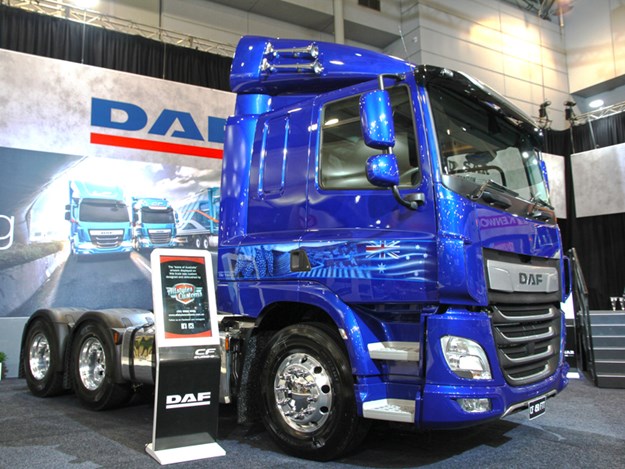 |
|
Livewire DAF. Assembled at Paccar’s Bayswater (Vic) factory, DAF CF model is now available with the sprightly MX-11 engine as well as the MX-13
|
Available in ratings from 370 to 410hp (276 to 306kW) and 450hp (336kW), and offered in the 6×4 CF at a gross combination rating of 60 tonnes, our few short stints in the MX-11 have shown the engine to be the spearhead of a remarkably lively and smoothly efficient DAF powertrain.
The MX engines are, however, simply the tip of the iceberg in Paccar Australia’s ambitions for the DAF range. Indeed, big things are brewing both locally and overseas which, from next year and beyond, will have a major impact on Paccar’s cab-over class – DAF and Kenworth. Stay tuned, because there’s also a big story brewing on these developments.
For Safety’s Sake
Just as it was two years ago, staring straight across the aisle at Paccar’s presentation was Daimler’s Freightliner Cascadia. Unlike 2019, though, when a right hand-drive Cascadia was still a work in progress, North America’s biggest selling truck is now pushing ahead with bold ambitions for the Australian market. And it is not without a very powerful and expedient tool in the chest. Safety!
From the outset, Cascadia set a new and incredibly high benchmark for safety in conventional trucks with the standard inclusion of the Detroit Assurance 5.0 suite of advanced safety functions.
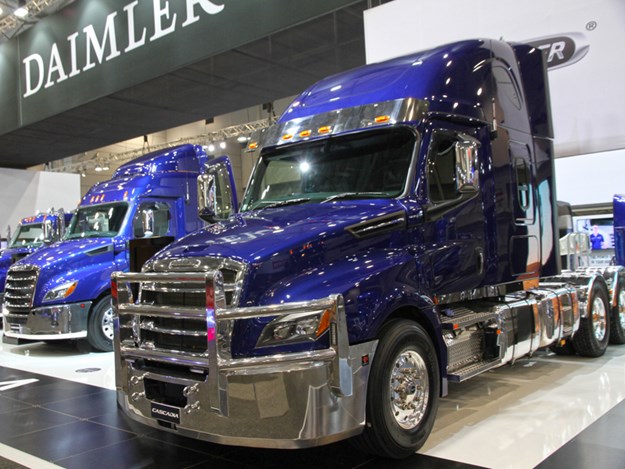 |
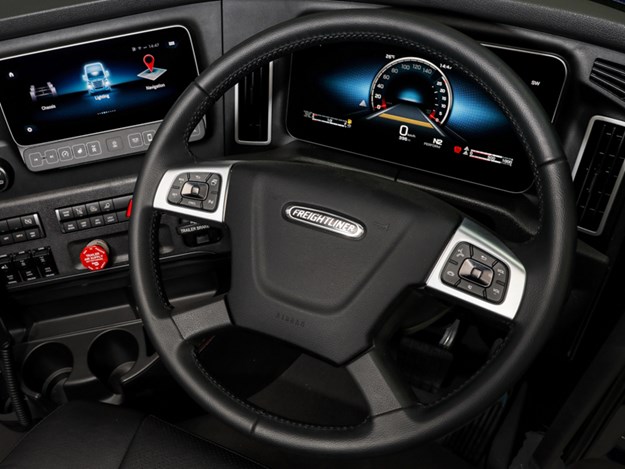 |
|
Safety first. Freightliner Cascadia takes conventional truck safety to an unmatched standard while, on the inside, the digital dash option creates a new dimension in function and form
|
But, as the company announced in Brisbane, it is about to push the safety stakes to an even higher level with the introduction late this year of a head-protecting side airbag in addition to the existing steering wheel airbag.
Right now, and for what will be probably quite some time to come, Cascadia is unrivalled in conventional truck safety.
Typically, Daimler Trucks Australia boss Daniel Whitehead didn’t pull any punches in citing Cascadia’s credentials and, specifically, the need to protect drivers no matter what brand of truck they drive.
“There is no good reason why conventional truck drivers in Australia should not be able to drive a truck fitted with the latest safety features,” he said in a prepared statement.
“It doesn’t matter whether you are driving a truck with or without a bonnet, your safety is just as important.”
As Freightliner’s announcement added, the head-protecting side airbag has been specially developed for the Australian market by RollTek and America’s IMMI, industry leaders in the design, testing and manufacturing of advanced safety systems.
Meanwhile, a number of the Cascadias on display also featured a digital dashboard layout that will become optional later this year.
Largely identical to the digital dash already available on Mercedes-Benz models, it’s a layout using a 312mm (12.3-inch)-wide screen as the main display directly in front of the driver for gauges, trip data and adaptive cruise control information and to the left, a 254mm (10-inch) touchscreen to access a range of ancillary functions.
Familiarity and ease of operation with the digital dash come quickly, as we’ve found in previous drives of Mercedes-Benz trucks where the system is known as the multi-media cockpit.
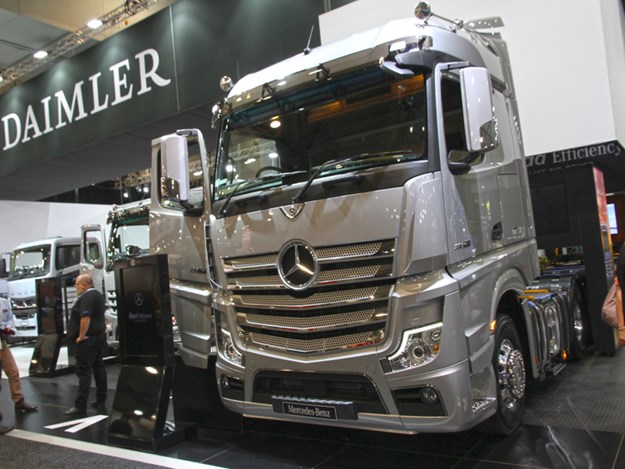 |
|
Star power: Top-of-the-tree Mercedes-Benz 2663 was joined by a rigid class now with a similarly high level of safety features. Benz will soon start testing a partially automated steering system in Australia
|
While Cascadia was unquestionably the star attraction for Daimler this year, the three-pointed star certainly wasn’t short of its own news, led by the announcement that Mercedes-Benz is set to launch an Australian validation program for an Actros that can help steer itself.
Known as ‘Active Drive Assist’ technology, a statement from Mercedes-Benz says the system enables a partially automated driving capability and is a first for the Australian market.
Mercedes-Benz states: “The system helps to actively steer the truck and keep it in the centre of its lane, although the driver is still required to hold the steering wheel.”
Also, says Benz: “It is one step ahead of some current systems [because] the Mercedes-Benz system actually helps steer the truck in the first place.” As the company insists: “Proactive rather than reactive.”
Apparently, we’ll be given a drive of Active Drive Assist before too long but it wasn’t the only news from Mercedes-Benz.
Until now, the Benz rigid range and specifically the Arocs 8×4 model, wasn’t available with the full suite of advanced safety functions used in prime mover models due to what were explained as “application-related packaging restrictions”.
Those engineering challenges have been overcome and the eight-wheeler now comes with the radar-based ‘Active Brake Assist’ package as well as existing safety features such as electronic stability program, driver airbag and lane departure warning.
Last, but definitely not least in Daimler’s truck triumvirate, is Fuso, easily the biggest selling brand in the group and using the Brisbane show to highlight the iconic Canter model’s 50-year milestone on the Australian market.
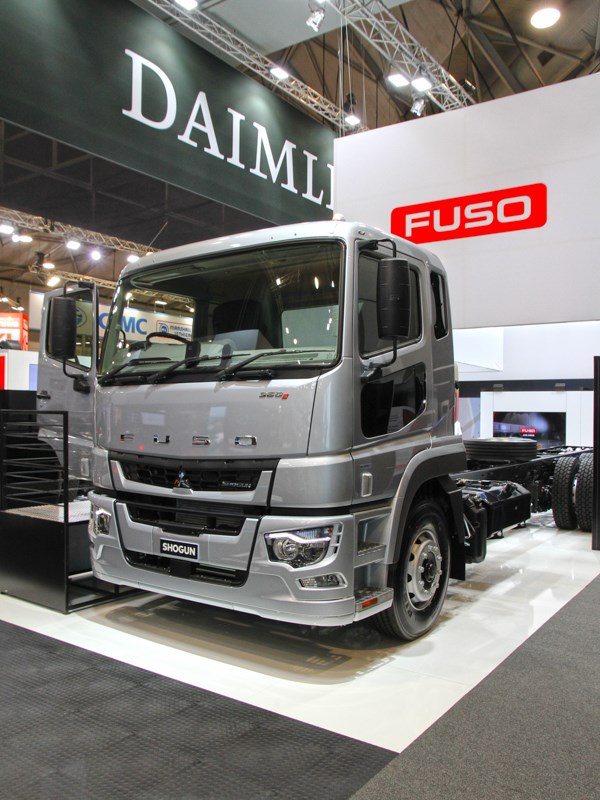 |
|
Fuso’s new Shogun 360 six-wheeler. Japanese toughness with Daimler smarts. A Euro 6 medium-duty Fighter was also released
|
It’s worth noting, too, that of the four Japanese truck suppliers in Australia, only Fuso attended the Brisbane show and, as one senior Daimler executive was quick to comment: “It’s their loss because we have plenty to show and plenty to talk about. It’s disappointing for the industry that the others aren’t here but, commercially, we don’t mind being the only Japanese brand on show. Not one bit.”
Emphasising the evolution of the remarkably durable Canter range, the light-duty Fuso is also the platform for the recently launched eCanter electric truck and, at a truck show where electric power was high among the highlights, the eCanter was certainly a timely addition to Daimler’s displays.
However, it was the launch of Fuso’s new Shogun 360 model, which perhaps had pragmatic truck operators most engaged.
According to Fuso, the Shogun 360 six-wheeler – available as a 6×2 or 6×4 – was developed as a premium 14-pallet rigid model equipped with Daimler’s extensive standard safety features, Euro 6 emissions compliance and a trim cab/chassis tare weight of 6,950kg.
Power comes from Daimler’s responsive 7.7-litre six-cylinder engine dispensing 360hp (268kW) and 1400Nm (1,030lb-ft) of torque through a 12-speed automated transmission that also provides the Eco-Roll fuel-saving feature and crawler modes for low-speed manoeuvring.
Continuing Daimler’s high level of standard safety features, the 360 comes with advanced emergency braking, lane departure warning, electronic stability program and Driver Attention Assist, which uses facial recognition technology to warn of fatigue.
It is, by any measure, an impressive package in the six-wheeler rigid class and, according to Fuso Australia chief Alex Müller, sizeable orders have already been taken.
Business Models
Michael May, the former head of Mercedes-Benz truck operations in Australia and now managing director of Iveco Trucks Australia, went straight to the point when previewing the company’s Brisbane display.
“Iveco is excited to be supporting the 2021 Brisbane Truck Show,” he said in an opening statement.
“The display vehicles highlight the benefits Iveco enjoys as a European manufacturer with a local research and development and manufacturing capacity, which ensures all vehicles are tailored to Australia’s unique operating conditions.”
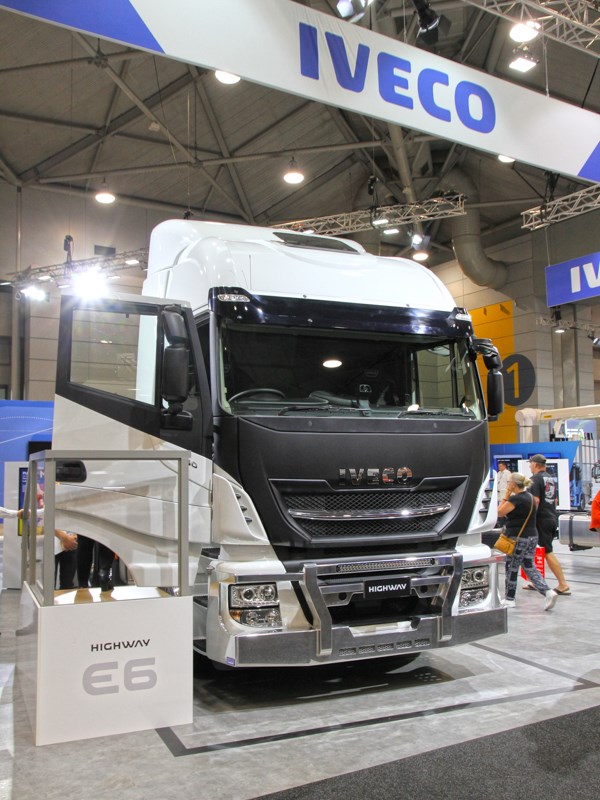 |
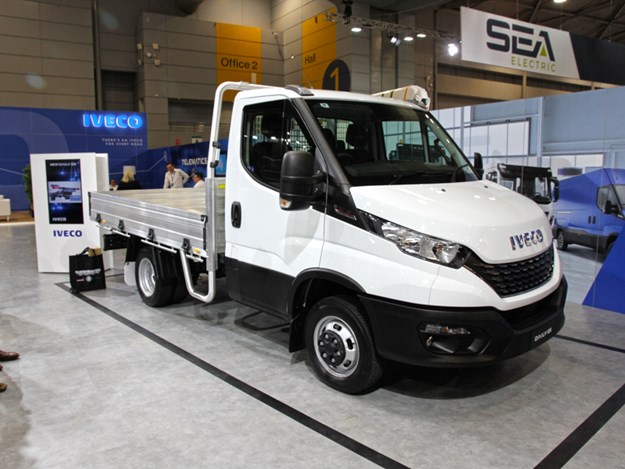 |
|
Wide appeal: Iveco was intent on showing a Euro 6 product range that covers many bases, from the latest light-duty Daily to the revamped Highway flagship.
|
Diversity was at the core of a four-model display ranging from the latest incarnation of the versatile and popular Daily light-duty line-up in its ‘Tradie-Made’ ready-to-work configuration through to the well-mannered medium-duty Eurocargo, the never-say-die ACCO in a typical 8×4 configuration with a Superior Pak front-loading compactor body, and at the top of Iveco’s on-road range, a ‘Highway’ heavy-duty model rated to 70 tonnes.
A quick look at the specifications of all Iveco’s show trucks confirmed an undeniably well-equipped range sporting advanced safety and Euro 6 emissions as standard features.
Away from the show, however, another Iveco was doing its bit to not only support the broader industry, but also confirm the breadth of the brand’s engineering and manufacturing capabilities.
As a company statement explained: “In addition to its support of the Brisbane Truck Show, Iveco is also supporting the Southbank Truck Festival with display of a Q-FE ‘Road Ant’,” described as being “a dual control, forward moving aggregate spreader based on an ACCO six-wheeler fitted with a Trout River, asphalt-compatible body and 10-gate chip spreader.”
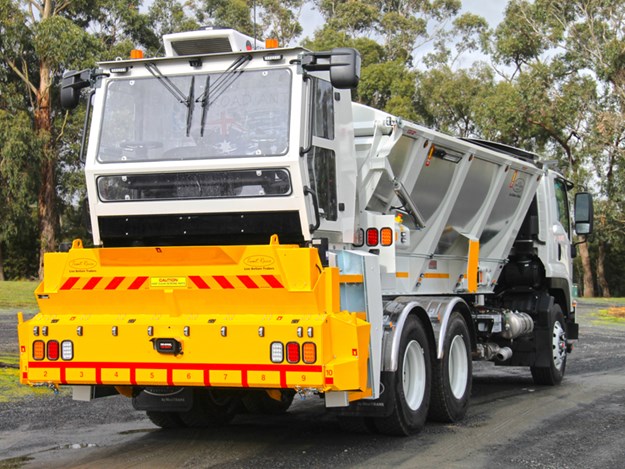 |
|
Meanwhile, over at the Southbank Truck Festival was the unique ‘Road Ant’, an aggregate spreader based on an ACCO that can be driven independently from both ends of the vehicle
|
Its creation stems from a recent VicRoads requirement, which mandates that from July 1, 2022, all aggregate spreaders working in sprayed sealing applications must be forward-moving. Consequently, the ‘Road Ant’ can be driven independently from both ends of the vehicle.
Meanwhile, back at the show, the Penske pair of Western Star and MAN certainly weren’t without plenty of people keen for a close look at a couple of big bangers.
Top of the list was Western Star’s 4900FXC, destined for heavy-duty roadtrain roles with a 600hp (447kW) Cummins X15 powering into an Eaton 18-speed overdrive – manual, of course – and Dana rear axles running a 4.56:1 final drive ratio, mounted on Neway airbag suspension.
Yet, perhaps one of the most underrated or overlooked features of Western Star these days is the Stratosphere sleeper. According to many people we’ve spoken to over the many years since Stratosphere first arrived here, it is the best bunk layout in the business and there’s little doubt the premium 82-inch (208cm) high-rise shed on the back of the 4900 show truck was a solid reminder to most.
 |
 |
|
Big bangers: The Penske pair of MAN and Western Star. Insiders say there are new models coming for both brands next year
|
When it comes to muscle, though, MAN’s flagship TGX 640 carries the flag in the Penske portfolio. This is an impressively strong truck to drive but, unfortunately, durability issues haven’t been kind to buyers and the brand alike.
Still, while Penske insiders didn’t deny the brand’s “chequered past”, there’s confidence that a new MAN range due in 2022 will help right the wrongs, perceived or otherwise. Critically, they also say Penske is committed to the brand’s future in Australia.
Similarly, an entirely new Western Star range launched in the US last year is said to be heading our way in 2022.
Trident Tribute
While neither Cummins nor Mack attended the 2021 Brisbane Truck Show, Followmont Transport’s display of a Cummins-powered Mack Trident was a magnanimous and highly fitting tribute to a true stalwart of the trucking industry, the late Col Baker.
A Cummins man to the core and immensely proud Queenslander despite a move to Cummins HQ in Melbourne, Col passed away only days before the Brisbane show after a fiercely fought battle with cancer. He was just 52-years-old and is survived by his wife Jenny and three daughters.
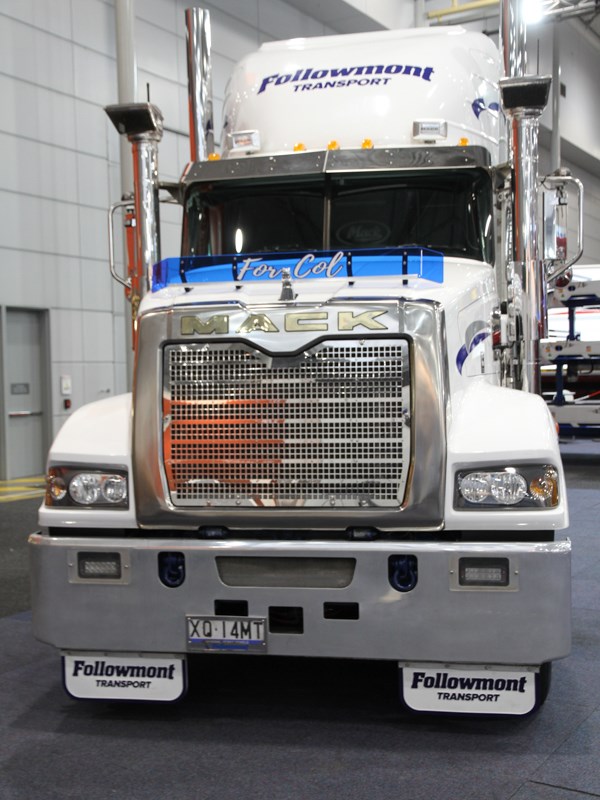 |
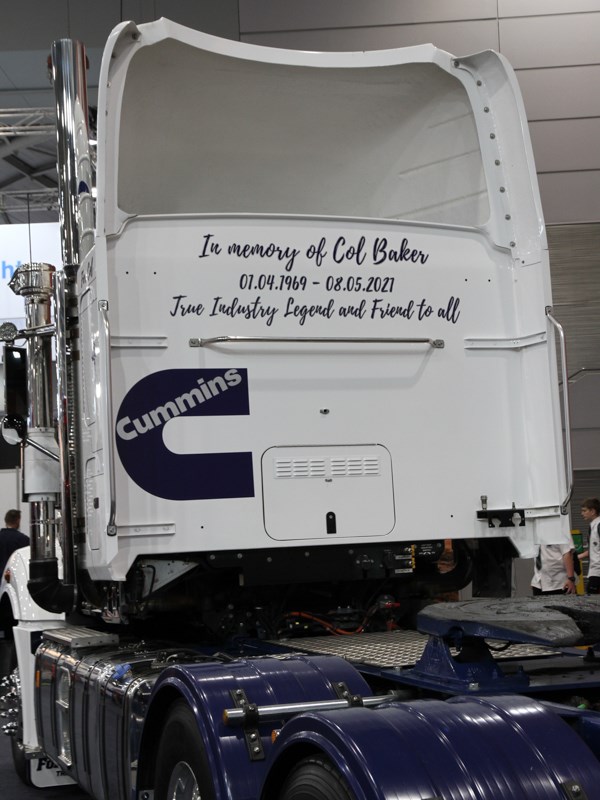 |
|
Followmont Transport’s tribute to Col Baker. A Cummins man to the core and true stalwart of the trucking industry
|
In what was something of a secret project between Cummins and the Brisbane-based transport company, Col worked closely with Followmont Transport principal Mark Tobin to slot an X15 engine under the Trident snout for an extensive trial, with the trust and respect between the two manifesting in Tobin’s heartfelt tribute to his Cummins mate.
“Col Baker was the best example of living out the values of integrity, caring, teamwork and the pursuit of excellence,” says close friend and Cummins colleague, Mike Fowler.
“The courage he demonstrated during his fight with cancer was nothing short of inspirational but in truth, it was just so typical of him.
“Cummins and the wider trucking industry have lost someone very special.”
Absolutely!
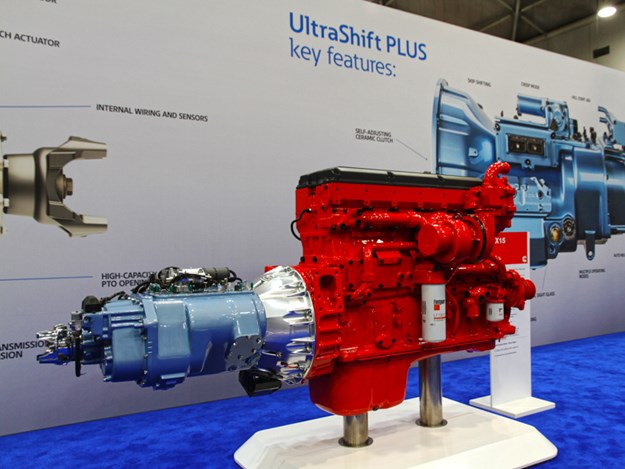 |
|
Cummins was missing in action but technology partner Eaton waved the flag for both brands. Expect some big news from the transmission specialist as it prepares to test a new Endurant family
|
Gas and Electric
Down the power scale, South Korean brand Hyundai, exhibiting through its Brisbane-based East Coast Hyundai distributor, appeared to attract plenty of interest in its new medium-duty addition called the Pavise.
Available in weight ratings from 12 to 12.9, 15.5 and 17.6 tonnes, and wheelbase lengths of 4.3, 4.9 and 5.7 metres, all Pavise models are powered by a turbocharged 5.9-litre Euro 5 six-cylinder diesel rated at 276hp (206kW) in the top weight model and 246hp (183kW) in all others.
Coupled to the engine in all models is the choice of a nine-speed ZF manual transmission or a 12-speed automated box, also from ZF.
 |
|
Korean connection. With the absence of three of Australia’s four Japanese truck brands, there was ample interest in Hyundai’s new Pavise medium-duty models
|
All models come with an extensive range of advanced safety features, including autonomous emergency braking, forward collision avoidance system and airbags for driver and passenger.
Somewhat surprisingly, though, there was no Hyundai Xcient on show. Xcient is Hyundai’s flagship heavy-duty contender and, while Australian sales continue to be ghostly thin, it is the platform model for the South Korean maker’s well publicised plans to become a major player in the development of hydrogen-fuelled trucks.
Several Chinese commercial vehicles were also on show in Brisbane, including the much maligned JAC brand now attempting a comeback with a light-duty electric truck.
In fact, electric power was on show at every level, from the light EC11 Chinese van currently under evaluation, to the well-publicised SEA Electric venture, which has attracted former Hino executive Bill Gillespie to a top management role, and at the top of the weight scale, the undeniably innovative Janus electric heavy-duty truck.
Following an earlier announcement that it will revolutionise heavy-duty road transport with its patented exchangeable battery system, Janus Electric showcased its prototype model based on a converted Kenworth T403.
With its exchangeable battery packs, Janus principals insist its system removes the need for heavy electric vehicles to stand idle for up to 12 hours waiting for batteries to recharge.
 |
|
Electric power was high among the highlights in Brisbane with none bigger than the innovative Janus heavy-duty system of exchangeable batteries. The batteries power an electric motor from Dana Spicer
|
Instead, says Janus, battery packs can be swapped by forklift in a matter of minutes to dramatically enhance vehicle utilisation.
Janus director Lex Forsyth says operator interest in the system is exceptionally strong and, with confidence running high, the company has worked with Kenworth to supply a T610 ‘glider’ for further testing and development.
Typically, perhaps, the Janus system has already drawn an undercurrent of cynics, but this innovative Australian approach to electric truck viability appears to have significant potential.
Two years from now at the next Brisbane Truck Show, we’ll know if the potential is being realised or not.
Even more certain, those brands missing from this year’s event will be clamouring to come back in 2023.
.jpg) |
|
Judging by the crowds it drew the Legend SAR was definitely the star of BTS21
|


